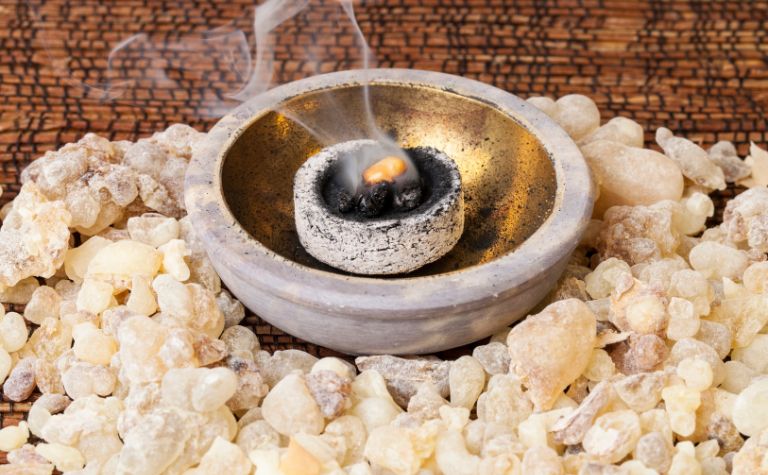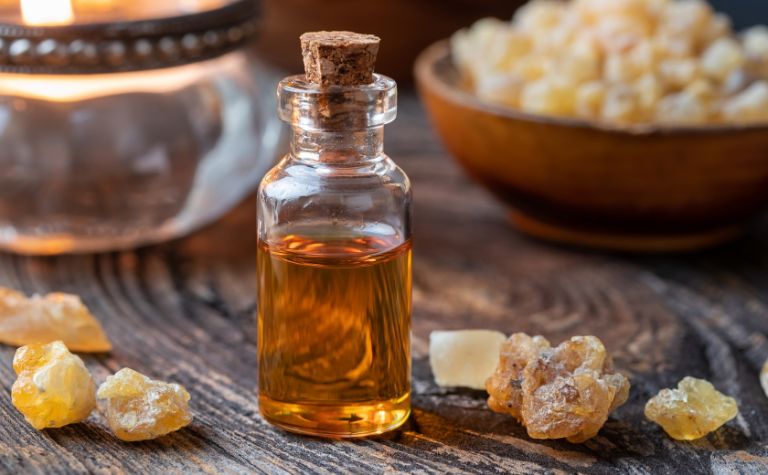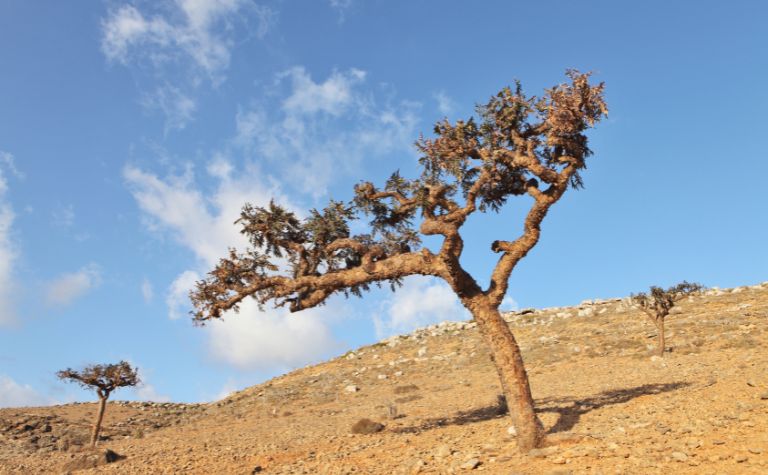Frankincense, a resin extracted from the Boswellia tree, has been a staple in cultural and historical practices for thousands of years.
Hailing from regions in Africa and the Middle East, this aromatic substance has transcended its traditional uses in ceremonies and rituals, finding its way into modern perfumery and aromatherapy.
Often recognized for its role in ancient stories and texts, frankincense’s allure is not just in its history but also in its distinct scent.
This article aims to describe the unique aroma of frankincense, compare it to other resins, and explore its modern-day applications in the world of fragrances.

Primary Aromatic Notes of Frankincense
Frankincense possesses a scent profile that is both complex and captivating.
At its core, the aroma is often described as woody and resinous, evoking the image of ancient forests.
Accompanying this base note is a slight hint of citrus, imparting a fresh and uplifting quality to the resin.
Additionally, many individuals detect a subtle spicy undertone reminiscent of pepper or even a touch of camphor.
This spicy characteristic adds depth and warmth to the overall fragrance, making frankincense a sought-after ingredient in many aromatic blends.
Another notable aspect of frankincense’s scent is its ethereal or meditative quality.
A certain balsamic sweetness can be sensed, lending the resin a soothing and calming characteristic.
This could explain its historical use in meditation and spiritual practices across various cultures.
Over time, as frankincense is exposed to air, its aroma may deepen and evolve, revealing more of its earthy undertones.
This transformative nature is one of the reasons frankincense remains a cherished and versatile ingredient in perfumery.
Its multifaceted scent can complement a wide array of other fragrances, from florals to musks, making it both a foundational and complementary component in scent compositions.

Undertones and Subtle Fragrances
While the primary aroma of frankincense is distinct and recognizable, its undertones and subtler fragrances add layers of depth that make it truly unique.
One of the enchanting features of frankincense is that its scent profile is not static.
These undertones can vary significantly depending on the region it’s sourced from and the specific species of the Boswellia tree it originates from.
Pine-like freshness is one of the first subtleties many people identify when introduced to frankincense.
This crispness often melds seamlessly with a lemony or citrusy nuance, giving the resin a bright and rejuvenating edge. For some, this can evoke a sense of clarity and invigoration.
On the other end of the spectrum, frankincense can also carry a soft, almost vanilla-like sweetness.
This creaminess can sometimes be paired with a hint of musk, lending the resin a rich, comforting, and grounding depth.
This particular combination is what often gives frankincense its reputation for promoting tranquility and introspection.
Lastly, frankincense has an occasional smoky aspect reminiscent of a campfire or burning wood.
This aroma is especially prominent when the resin is burned as incense.
It’s a scent that ties frankincense back to its ancient roots when its fragrant smoke was seen as a bridge between the earthly and the divine.

Comparison to Other Resins and Incenses
When juxtaposed with other popular resins and incense, understanding the scent profile of frankincense becomes clearer.
For many, the act of comparing aromas provides a familiar anchor, allowing them to better appreciate the nuances of each scent.
One commonly known resin is myrrh, which, like frankincense, has ancient roots and is often mentioned in historical texts.
Myrrh’s scent is earthier and more balsamic, with a slight medicinal quality.
While frankincense carries uplifting and fresh undertones, myrrh tends to be denser, with a warmer and slightly sweet profile.
Copal, another cherished resin, bears some similarities to frankincense but is sweeter and has hints of a citrus aroma.
Originating primarily from Central America, copal has a light, clean aroma, often described as “friendly” or “inviting,” contrasting the deeper meditative qualities of frankincense.
Benzoin, hailing mainly from Southeast Asia, presents a rich, vanilla-like aroma, blending sweetness with a cozy warmth.
While frankincense offers a sense of clarity and introspection, benzoin provides a comforting embrace, enveloping spaces with its alluring scent.
When comparing frankincense to these and other resins, it stands out for its balanced blend of freshness and depth, making it a favorite in many cultural and historical contexts.
The journey of exploring these scents is a testament to the rich tapestry of aromas that nature offers, each with its unique story and significance.
Factors Influencing the Scent of Frankincense
Frankincense, though widely recognized, can vary in its aroma based on several factors.
Understanding these can provide a more comprehensive view of its diverse scent profile.
Firstly, the species of the Boswellia tree from which frankincense is harvested plays a significant role.
With multiple species scattered across different regions, the resulting resin can exhibit variations in scent.
For instance, Boswellia sacra, found in Oman, produces a frankincense that is often described as bright and citrusy.
In contrast, Boswellia carterii, native to East Africa, yields a deeper, more resinous aroma.
Geographical and climatic conditions also contribute to these variations.
The soil, altitude, and weather conditions in which the Boswellia tree grows can influence the aromatic compounds present in the resin.
Trees in more arid conditions, facing intense sunlight, may produce frankincense with a more concentrated scent profile compared to those in milder climates.
Harvesting and processing techniques further impact the fragrance.
The time of year when the tree bark is incised, the method of extraction and the drying process can all bring about subtle changes in the resin’s aroma.
Lastly, age can alter the scent. As frankincense resin ages, its aroma can become richer and more refined.
This maturation process is sometimes sought after, with older resins being particularly valued for their evolved scent profile.
Recognizing these factors adds depth to the appreciation of frankincense, revealing the myriad of nuances that lie within its iconic aroma.
Uses of Frankincense in Modern Perfumery
Frankincense, with its rich history, has found a revered place in the world of modern perfumery.
This ancient resin’s unique and multifaceted aroma brings depth, warmth, and a touch of the exotic to contemporary fragrances.
Frankincense often acts as a base or middle note in perfumery, providing a grounding element that can anchor more volatile top notes.
Its natural resinous and woody scent pairs well with a myriad of other ingredients, from floral to spicy to citrus, allowing for a wide range of fragrance compositions.
Frankincense is especially prevalent in oriental and woody perfume categories.
Its inclusion often imparts a sense of mystique reminiscent of ancient rituals and far-off lands.
The resin’s ability to evoke both the ancient and the modern makes it a favorite among perfumers looking to create scents with a timeless quality.
The resin’s smoky and balsamic undertones are also utilized in perfumes, aiming for a warm and comforting ambiance.
Such fragrances are often associated with colder months, evoking the coziness of indoor warmth against a chilly backdrop.
In recent years, there has been a surge in interest in natural and niche perfumes.
Frankincense, being a natural ingredient with a storied past, has become increasingly sought after in these circles.
Its complex scent profile allows it to stand out, even as it seamlessly blends with a multitude of other ingredients.
In conclusion, frankincense’s enduring appeal and versatile aroma ensure its continued prominence in the evolving world of modern perfumery.
Whether in a classic concoction or a contemporary creation, its presence is a nod to both tradition and innovation.
Related Questions
Joseph, the husband of Mary and the earthly father of Jesus Christ, is depicted in the Gospels as humble, law-abiding, and obedient. In many Christmas scenes, such as in displays of the manger, he is...
The virgin Mary, the mother of Jesus, is one of the most fascinating people in the Bible. For 2,000 years, people of different eras and cultures have marveled at her faith in God. Mary's story in the...
